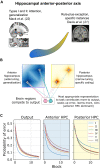A multilevel account of hippocampal function in spatial and concept learning: Bridging models of behavior and neural assemblies
- PMID: 37478189
- PMCID: PMC10361583
- DOI: 10.1126/sciadv.ade6903
A multilevel account of hippocampal function in spatial and concept learning: Bridging models of behavior and neural assemblies
Abstract
A complete neuroscience requires multilevel theories that address phenomena ranging from higher-level cognitive behaviors to activities within a cell. We propose an extension to the level of mechanism approach where a computational model of cognition sits in between behavior and brain: It explains the higher-level behavior and can be decomposed into lower-level component mechanisms to provide a richer understanding of the system than any level alone. Toward this end, we decomposed a cognitive model into neuron-like units using a neural flocking approach that parallels recurrent hippocampal activity. Neural flocking coordinates units that collectively form higher-level mental constructs. The decomposed model suggested how brain-scale neural populations coordinate to form assemblies encoding concept and spatial representations and why so many neurons are needed for robust performance at the cognitive level. This multilevel explanation provides a way to understand how cognition and symbol-like representations are supported by coordinated neural populations (assemblies) formed through learning.
Figures




References
-
- C. F. Craver, Explaining the Brain (Oxford Univ. Press, 2007).
-
- D. Marr, T. Poggio, “From understanding computation to understanding neural circuitry” (AIM-357, Massachusetts Institute of Technology 201 Vassar Street, W59-200, 1976), vol. 357.
-
- D. Marr, Vision: A Computational Investigation into the Human Representation and Processing of Visual Information (MIT Press, 2010).
-
- J. Bickle, Marr and reductionism. Top. Cogn. Sci. 7, 299–311 (2015). - PubMed
Publication types
MeSH terms
Grants and funding
LinkOut - more resources
Full Text Sources

